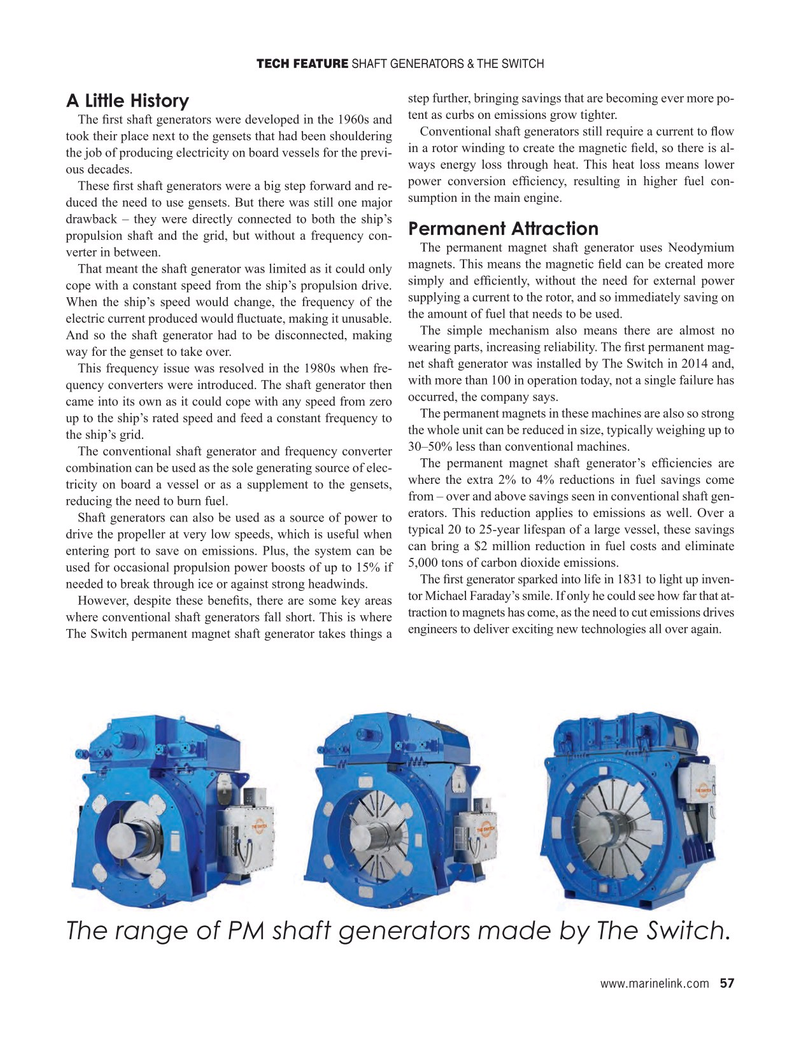
Page 57: of Maritime Reporter Magazine (May 2023)
Green Ship Technologies
Read this page in Pdf, Flash or Html5 edition of May 2023 Maritime Reporter Magazine
TECH FEATURE SHAFT GENERATORS & THE SWITCH step further, bringing savings that are becoming ever more po-
A Little History
The ? rst shaft generators were developed in the 1960s and tent as curbs on emissions grow tighter.
Conventional shaft generators still require a current to ? ow took their place next to the gensets that had been shouldering in a rotor winding to create the magnetic ? eld, so there is al- the job of producing electricity on board vessels for the previ- ways energy loss through heat. This heat loss means lower ous decades. power conversion ef? ciency, resulting in higher fuel con-
These ? rst shaft generators were a big step forward and re- duced the need to use gensets. But there was still one major sumption in the main engine.
drawback – they were directly connected to both the ship’s
Permanent Attraction propulsion shaft and the grid, but without a frequency con-
The permanent magnet shaft generator uses Neodymium verter in between.
That meant the shaft generator was limited as it could only magnets. This means the magnetic ? eld can be created more cope with a constant speed from the ship’s propulsion drive. simply and ef? ciently, without the need for external power
When the ship’s speed would change, the frequency of the supplying a current to the rotor, and so immediately saving on the amount of fuel that needs to be used. electric current produced would ? uctuate, making it unusable.
The simple mechanism also means there are almost no
And so the shaft generator had to be disconnected, making wearing parts, increasing reliability. The ? rst permanent mag- way for the genset to take over.
net shaft generator was installed by The Switch in 2014 and,
This frequency issue was resolved in the 1980s when fre- quency converters were introduced. The shaft generator then with more than 100 in operation today, not a single failure has came into its own as it could cope with any speed from zero occurred, the company says.
The permanent magnets in these machines are also so strong up to the ship’s rated speed and feed a constant frequency to the whole unit can be reduced in size, typically weighing up to the ship’s grid.
The conventional shaft generator and frequency converter 30–50% less than conventional machines.
The permanent magnet shaft generator’s ef? ciencies are combination can be used as the sole generating source of elec- tricity on board a vessel or as a supplement to the gensets, where the extra 2% to 4% reductions in fuel savings come from – over and above savings seen in conventional shaft gen- reducing the need to burn fuel.
Shaft generators can also be used as a source of power to erators. This reduction applies to emissions as well. Over a drive the propeller at very low speeds, which is useful when typical 20 to 25-year lifespan of a large vessel, these savings entering port to save on emissions. Plus, the system can be can bring a $2 million reduction in fuel costs and eliminate used for occasional propulsion power boosts of up to 15% if 5,000 tons of carbon dioxide emissions.
The ? rst generator sparked into life in 1831 to light up inven- needed to break through ice or against strong headwinds.
However, despite these bene? ts, there are some key areas tor Michael Faraday’s smile. If only he could see how far that at- where conventional shaft generators fall short. This is where traction to magnets has come, as the need to cut emissions drives
The Switch permanent magnet shaft generator takes things a engineers to deliver exciting new technologies all over again.
The range of PM shaft generators made by The Switch. www.marinelink.com 57
MR #5 (50-60).indd 57 5/4/2023 8:56:52 AM

 56
56

 58
58
